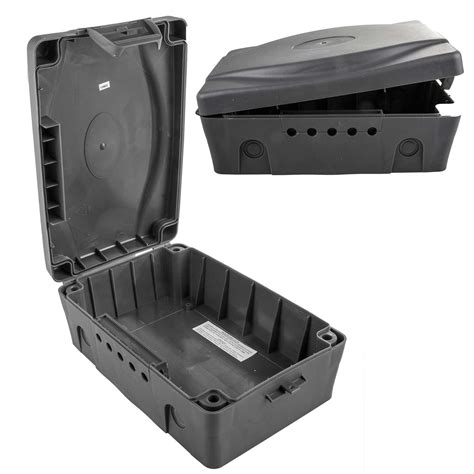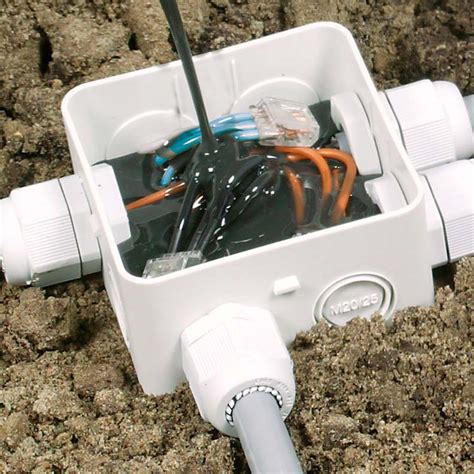electrical utility box sizes Correct fill capacity: The junction box should be large enough to contain the wires. . Overview of molten metal sonochemistry, showing main methods of metal micro/nanoparticle fabrication, properties, mechanisms and future potential applications.
0 · waterproof electric outlet box
1 · underground waterproof electrical box
2 · types of utility box electrical
3 · standard electrical box size chart
4 · residential electrical outlet boxes
5 · lowe's electrical outlet boxes
6 · home depot electrical outlet box
7 · electrical outlet box for drywall
It's going to depend on what material is covering the soffit. If it's aluminium/plastic soffit covers, you'll have to remove the section where you're installing the receptacle. Install proper bracing (a simple 2x4 between the rafters should be fine), and attach the electrical box to it.
Electrical boxes encase wire connections to protect them from short circuits. They are vital for fire safety and are used for receptacles, ceiling fans, outside outlets, and more. Unless the device is one of the few that contains its own wires, it likely will need an electrical box.When you install an electrical box, make sure it is flush with the surface of this .A junction box is an electrical box that allowed two or more electrical cables to .Prepare the Electrical Box Opening in the Wall . Create the wall cutout. Position .
Correct fill capacity: The junction box should be large enough to contain the wires. .To install this type of clamp, insert the threaded end into a knockout hole in the .
Here we describe matching 15-Amp receptacles to 15-Amp circuits, 20-Amp receptacles to 20-Amp circuits, two-wire receptacles where no ground is present, GFCI and AFCI electrical . Wires, receptacles and switches need adequate space. Crowded boxes can damage wires, resulting in a fire or shock hazard. You can use the chart below to calculate the .

precision metal fabricator training
Electrical Boxes vary in size, material, number of gangs, and shape and are designed for specific uses like junctions, outlets, and switch or fixture boxes for wiring in wall or ceiling. Use this .There is a huge selection of electrical boxes, varying by size, shape, mounting device, and composition. One of the first distinctions to note is that of new work boxes and remodel or cut-in boxes. Electrical boxes come in various sizes and configurations, each designed for specific applications and installation requirements. In this article, we will explore the different standard sizes of electrical boxes and their common .But don’t worry: Most electrical boxes fall into nine main types, specializing in a load rating tailored to specific tasks and electric appliances. 1. Metal and Plastic Electrical Boxes. The majority of electric boxes are metal or plastic. Most .
The National Electrical Code (NEC) provides guidelines for box sizing based on the number and size of wires you're working with. The NEC specifies the minimum volume of the box in cubic inches (cu. in.) that you . Electrical boxes encase wire connections to protect them from short circuits. They are vital for fire safety and are used for receptacles, ceiling fans, outside outlets, and more. Unless the device is one of the few that contains its own wires, it likely will need an electrical box. Choosing the Right Electrical Box for Your Project. Selecting the appropriate electrical box depends on several factors, including construction, wiring method, devices, location, and safety. Type of Construction. Your project’s construction type influences the choice of .Here we describe matching 15-Amp receptacles to 15-Amp circuits, 20-Amp receptacles to 20-Amp circuits, two-wire receptacles where no ground is present, GFCI and AFCI electrical receptacles, and the proper electrical box to hold and mount these devices.
Wires, receptacles and switches need adequate space. Crowded boxes can damage wires, resulting in a fire or shock hazard. You can use the chart below to calculate the required box size. Add up the numbers for the correspond- ing components in the box to find how many cubic inches you’ll need.
Electrical Boxes vary in size, material, number of gangs, and shape and are designed for specific uses like junctions, outlets, and switch or fixture boxes for wiring in wall or ceiling. Use this guide to determine the best electrical box choice for your application.
There is a huge selection of electrical boxes, varying by size, shape, mounting device, and composition. One of the first distinctions to note is that of new work boxes and remodel or cut-in boxes. Electrical boxes come in various sizes and configurations, each designed for specific applications and installation requirements. In this article, we will explore the different standard sizes of electrical boxes and their common uses.But don’t worry: Most electrical boxes fall into nine main types, specializing in a load rating tailored to specific tasks and electric appliances. 1. Metal and Plastic Electrical Boxes. The majority of electric boxes are metal or plastic. Most indoor metal boxes are steel, while indoor plastic boxes are PVC or fiberglass. The National Electrical Code (NEC) provides guidelines for box sizing based on the number and size of wires you're working with. The NEC specifies the minimum volume of the box in cubic inches (cu. in.) that you need to accommodate your wires.
🙋 In this junction box calculator, we refer to the specifications provided by the National Fire Protection Association® (NFPA®) in the NFPA 70: National Electrical Code® 2020 (2020 NEC®) Article 314.28 Pull and Junction Boxes and Conduit Bodies.
Electrical boxes encase wire connections to protect them from short circuits. They are vital for fire safety and are used for receptacles, ceiling fans, outside outlets, and more. Unless the device is one of the few that contains its own wires, it likely will need an electrical box. Choosing the Right Electrical Box for Your Project. Selecting the appropriate electrical box depends on several factors, including construction, wiring method, devices, location, and safety. Type of Construction. Your project’s construction type influences the choice of .Here we describe matching 15-Amp receptacles to 15-Amp circuits, 20-Amp receptacles to 20-Amp circuits, two-wire receptacles where no ground is present, GFCI and AFCI electrical receptacles, and the proper electrical box to hold and mount these devices.
Wires, receptacles and switches need adequate space. Crowded boxes can damage wires, resulting in a fire or shock hazard. You can use the chart below to calculate the required box size. Add up the numbers for the correspond- ing components in the box to find how many cubic inches you’ll need.
Electrical Boxes vary in size, material, number of gangs, and shape and are designed for specific uses like junctions, outlets, and switch or fixture boxes for wiring in wall or ceiling. Use this guide to determine the best electrical box choice for your application.There is a huge selection of electrical boxes, varying by size, shape, mounting device, and composition. One of the first distinctions to note is that of new work boxes and remodel or cut-in boxes.
Electrical boxes come in various sizes and configurations, each designed for specific applications and installation requirements. In this article, we will explore the different standard sizes of electrical boxes and their common uses.But don’t worry: Most electrical boxes fall into nine main types, specializing in a load rating tailored to specific tasks and electric appliances. 1. Metal and Plastic Electrical Boxes. The majority of electric boxes are metal or plastic. Most indoor metal boxes are steel, while indoor plastic boxes are PVC or fiberglass. The National Electrical Code (NEC) provides guidelines for box sizing based on the number and size of wires you're working with. The NEC specifies the minimum volume of the box in cubic inches (cu. in.) that you need to accommodate your wires.
waterproof electric outlet box

List of elements for Power Distribution Wiring Diagram (3 of 3) for Toyota RAV4 2007: (behind center of dash) j/b 4 (behind left side of dash) junction connector a37
electrical utility box sizes|home depot electrical outlet box